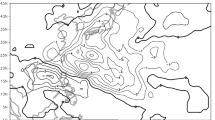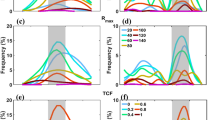Abstract
The 6-yr best-track data of tropical cyclones (TCs) in the western North Pacific are used to study the statistical features of TC size and radial wind profile. A TC size is defined as the azimuthal mean radius of 34-kt surface wind.
On average, the TCs in the western North Pacific have a size of 203 km, and the size is larger for stronger TCs. Further analyses show that larger TCs tend to move faster than smaller ones, with a 23–24 km difference in size corresponding to a difference of about 10 km h−1 in moving speed. The TCs that recurve from westward to eastward moving have a mean size of 218 km, significantly larger than that of those without a turning point (179 km). Regional TC distributions demonstrate that the TCs affecting the Korean Peninsula and southwestern Japan have the largest mean size (250–280 km). There are also some large TCs affecting southern Philippines, while TCs over the South China Sea are generally small in size. Comparison of intensity and size of all TCs during their lifespan demonstrates that a TC tends to reach its maximum size 6 h after it reaches its maximum intensity, and the decrease rate of size during the weakening stage of a TC is much smaller than the increase rate of size during its developing stage. Thus, linear regression relations between TC size and intensity are established for its developing and weakening stages respectively, which can be used as a forecast tool for TC size.
Features of TC radial wind profile are studied by analyzing a parametric wind model based on the radius data of 34-, 50-, and 64-kt surface winds. The results show that the shape parameter d most frequently takes the values of 0.3, 0.4, and 0.5. It generally increases (decreases) as the TC develops (weakens), implying a sharper (flatter) radial wind profile. Changes in d leads the tendency of intensity. The two parameters for the asymmetric model, namely p and q, are mostly 0.85–1.05 and 0–0.2, respectively, embodying the fact that the asymmetric component is generally much smaller than the symmetric component. The asymmetry in 34-kt surface wind is much stronger than that in 50- and 64-kt surface winds, with the maximum radius often in the northeast quadrant.
Similar content being viewed by others
References
Brand, S., 1972: Very large and very small typhoons of the western North Pacific Ocean. J. Meteor. Sci. Japan, 50(4), 332–341.
Chen Lianshou and Ding Yihui, 1979: Tropical Cyclones in Northwestern Pacific. China Science Press, Beijing, 16–17. (in Chinese)
Elsberry, R. L., 1994: Global Prospective on Tropical Cyclones. China Meteorological Press, Beijing, 6–127. (in Chinese)
Jan, H. C., R. S. Charles, S. L. Andrew, et al., 2002: The Joint Typhoon Warning Center Tropical Cyclone Best-Tracks, 1945–2000. http://www.usno.navy.mil/NOOC/nmfc-ph/RSS/jtwc/best-tracks/DISCLAIM ER_report.
John, Knaff, C. Guard, J. Kossin, T. Marchok, B. Sampson, T. Smith, and N. Surgi, 2006: Operational guidance and skill in forecasting structure change. Sixth International Workshop on Tropical Cyclones, WMO/CAS/www, 164–165.
Knaff, J. A., R. S. Charles, D. Mark, et al., 2007: Statistical tropical cyclone wind radii prediction using climatology and persistence. Wea. Forecasting, 22(4), 781–791.
Lei Xiaotu and Chen Lianshou, 2005: A method to construct tropical cyclone wind distribution models and estimate its characteristic parameters. Chinese Journal of Geophysics, 48(1), 25–31. (in Chinese)
Merrill, R. T., 1984: A comparison of large and small tropical cyclones. Mon. Wea. Rev., 112(7), 1408–1418.
Niu Xuexin and Zhu Chize, 1997: The forecast of wind circles in tropical cyclones. Journal of Tropical Meteorology, 13(4), 365–367. (in Chinese)
Stephen, B. C., and M. G. William, 2002: Variability of the outer wind profiles of western North Pacific typhoons: Classifications and techniques for analysis and forecasting. Mon. Wea. Rev., 130(8), 1989–2005.
Tian Yongxiang, Zhao Yuandong, and Jiang Yanru, 1998: Effect of tropical cyclone horizontal scale on its motion. Journal of Nanjing Institute of Meteorology, 21(3), 411–417. (in Chinese)
Author information
Authors and Affiliations
Corresponding author
Additional information
Supported by the National Basic Research Program of China (2009CB421505), National Natural Science Foundation of China (40730948 and 40921160381), Special Projects for Public Welfare (2005DIB3J104), Shanghai Science Committee Climb Plan (06DZ12011), and Special Projects for Public Welfare (Meteorology) of China Meteorological Administration (GYHY200906002 and GYHY201006008).
Rights and permissions
About this article
Cite this article
Lu, X., Yu, H. & Lei, X. Statistics for size and radial wind profile of tropical cyclones in the western North Pacific. Acta Meteorol Sin 25, 104–112 (2011). https://doi.org/10.1007/s13351-011-0008-9
Received:
Accepted:
Published:
Issue Date:
DOI: https://doi.org/10.1007/s13351-011-0008-9




